- 19 Days
- 6,189m.
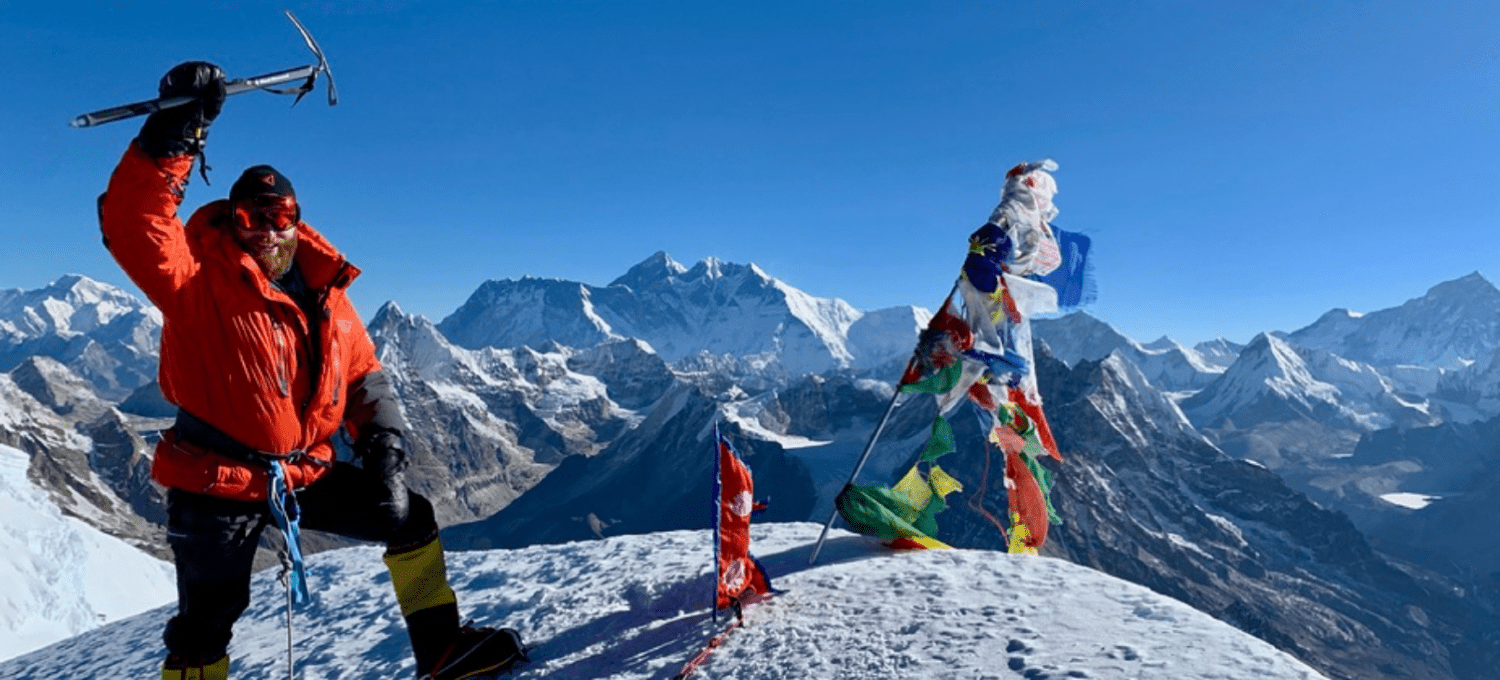
Nepal is known for its many beautiful lofty mountains. One of them is Mera Peak(6,461m), the tallest trekking peak in the world. And the fantastic journey to the top of the ridge is Mera Peak Climbing 14 Days.
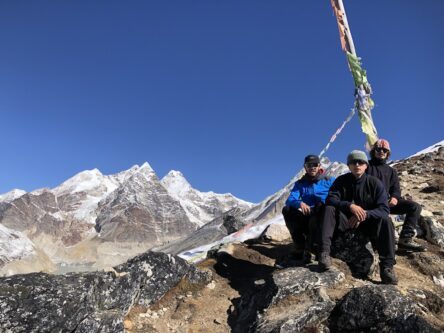
Mera Peak, the ultimate peak for beginners, is in the Mahalangur section of the Himalayas in the Khumbu Region. It lies 30 km south of Mt Everest, near some of the world’s tallest mountains.
As per the Nepalese Mountaineering Association, the peak is a trekking peak, proving it is not technical. That means it is a peak for beginners with basic climbing skills. If you know basic climbing skills and train physically, you can climb the mountain.
As the title says, it is a 14 days journey, the shortest of its kind. It starts from Kathmandu with a panoramic flight to Lukla. Afterward, your walk progresses gradually via Hinku Valley, an off-the-beaten side of the Everest Region.
The trek shows you the diverse and scenic terrains, lush greenery, breathtaking peaks, lovely people, unique lifestyles, and more of the region. The whole journey is as rewarding as the summit.
By trekking via the region, you will reach the foothills of the summit, Khare. The route ahead to Mera Peak is steep, rough, and snowy but non-technical. You will reach the top of Mera Peak using fundamental alpine skills via Mera High Camp.
The moment at the top will be a rewarding and memorable one. Mera Peak’s summit, the best vantage point in the region, will provide awe-striking expansive views of Mt Everest, Lhotse, Makalu, Cho Oyu, and many more.
After the climb, you will retrace Lukla via Khare, Kothe, and Thuli Kharka. A flight from Lukla to Kathmandu will be the last thing in the region. In this way, you will finish the Short Mera Peak Climbing in 14 days and gain valuable mountaineering experience.
The best time to climb Mera Peak is Autumn and Spring. Although Mera Peak Climbing is short and non-technical, you must be prepared and physically fit. Likewise, you must have trekking experience and basic mountaineering training for this expedition.
If you tick all these things and have an experienced guide, you will climb Mera Peak successfully.
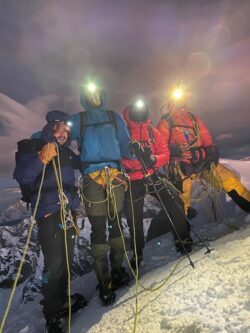
Mera Peak Climbing 14 Days follows one of the shortest routes to Mera Peak. The journey begins from Kathmandu with an exciting flight to Lukla. After 30 minutes, you will be in Lukla to start the Mera Peak Route, which starts from Lukla on the same day.
Leaving Lukla and the airport behind, you will trek toward Chhutang. The first day’s walk is up to Chhutang, lasting only several hours. From there, the route will lead to Thuli Kharka on the second day. Walking via Zatrwa La Pass, you will reach the yak pasture stop of Thuli Kharka.
After a night in Thuli Kharka, the walk will lead you to Kothe on the third day of Mera Peak. Similarly, you will trek to Thaknak from Kothe via the Hinku on the fourth day. The next day, you will progress from Thaknak to Khare, the base camp village of Mera Peak. You will spend an acclimatization day in Khare.
Now the climbing part starts. You will ascend to Mera High Camp from Khare. After the night in Mera High Camp, you will summit Mera Peak on the ninth day of the expedition. After a brief moment on the top, you will descend to Khare on the same day.
The walk-off from Mera Peak will happen via the same route. By tracing Khare, Kothe, Thuli Kharka, and Zatrwa La Pass, you will reach Lukla. You will need two days to trek from Khare to Lukla. On the thirteenth day of the expedition, you will fly to Kathmandu and finish the journey.
This route, as mentioned above, is off-the-beaten and perfect for those who want to climb Mera Peak quickly.
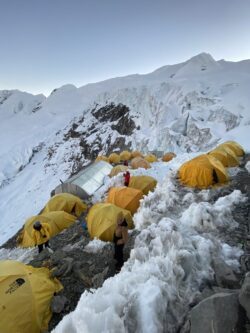
The best time to do Mera Peak Climbing is in the Autumn season. It is the peak time for adventure activities in Nepal, including mountaineering. Autumn lasts from September to November for three months in Nepal.
During this season, the weather is perfect for peak climbing. You will get a dry and stable climate, the skies are blue, and the sun is bright. The temperature is also manageable. Therefore, Autumn is the high time for Mera Peak Climbing.
Likewise, Spring, from March to May, is another good time for Mera Peak. It is another high time for climbing in Nepal. You will meet many climbers on the trail this season.
Like Autumn, the weather is fine and stable. The days are long and sunny. It is a season of flowers, mainly Rhododendrons, in Nepal. You will see many of them. However, there can be some precipitation in the late Spring. Overall, Spring also favors good climbing conditions.
On the contrary, Winter and Monsoon, the two remaining seasons, are not so ideal for Mera Peak. The weather conditions are unstable and difficult in these two seasons. Winter is a highly crispy time to be in the mountains from December to February.
From June to August, the monsoon is a high precipitation time in Nepal. You have to deal with unsuitable climatic conditions. The county receives massive rainfall during this season. Mountains get blocked, trails get slippery, and other similar things happen in Monsoon. Hence, quite a few people do Mera Peak climbing in Monsoon.
Overall, Mera Peak Climbing is ideal in Autumn and Spring. However, climbing Mera Peak is possible in Monsoon and Winter too.
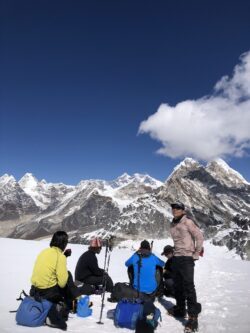
Mera Peak is a nontechnical trekking peak in Nepal. Although it is the highest trekking peak, climbing Mera Peak is simple. The height is perfect even for non-experienced climbers.
However, there are difficulties in Short Mera Peak Climbing for sure. The journey to the pinpoint of Mera Peak requires weeks of trekking and climbing. Climbers have to reach Mera Peak base camp from Lukla by trekking via the uneven terrain of the Everest region. It involves walking in steep, downhill, rough, icy, and high-altitude terrains.
Likewise, the expedition takes you over 6000m+ altitude. Every day, there will be some altitude gain or loss. You need to acclimatize to the elevation in a short time.
The increasing altitude will have its challenges.
Remember, the weather conditions in the higher parts are tricky. The regions undergo cold temperatures throughout the year. While in such areas, you have to keep yourself warm.
Overall, Mera Peak Climbing is an accessible peak. There are several challenges of the climb. However, you can overcome those with the right sort of climbing training and physical training. Also, you need the right team for the expedition to lead you.
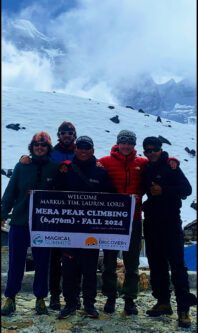
Mera Peak is one of the tallest trekking peaks in Nepal, with a height of 6,476m. The peak is technically easy, with no technical alpine skills needed. It is doable by beginners, hence famous among newbies. However, there is a need for a good physique and fitness and some trekking experience in the mountains.
It is more than perfect if you have experience trekking in the Himalayas. The experience will help you physically and mentally. The conditions in the mountains will be familiar to you. Having prior trekking or climbing experience is quite helpful.
You also must have a sound fitness level that can endure the steep and rough terrain of the climb. The trail to Mera Peak is steep and ascending. You have to push yourself, for which you need a good physique. Cardio training and strength training are two options for it.
Plus, basic climbing prowess is also compulsory for the expedition. The skills are like using crampons, ice axes, and ropes. You can learn these skills by doing basic mountaineering training.
You can take on this climb if you have the things mentioned earlier.
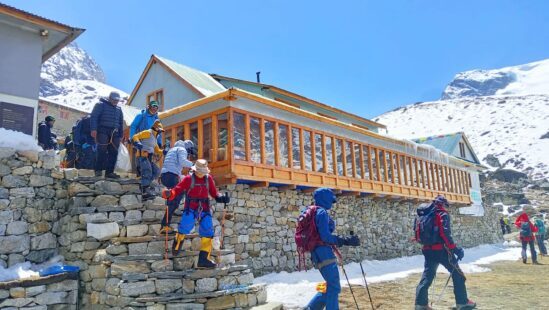
On 14 Days Short Mera Peak climbing, you will stay in basic lodges or tea houses along the way until Khare. There are enough accommodation facilities from Lukla to Khare. The accommodations are standard but comfortable enough to relax and rest. You usually get shared rooms with two beds, blankets, and pillows. You may also get attached bathrooms in some places.
The identical tea houses or lodges provide good, fresh, organic meals. You can have meals like Dal Bhat, Curies, Soups, Noodles, dumplings, Bread, sandwiches, etc. Some lodges also sell bakeries, while hot beverages like tea and coffee are readily available.
While climbing the mountain, you will stay in tents set by your team. You have to use sleeping bags and other camping gear for the nights. Likewise, the kitchen staff will cook and serve you food. The variety of meals will be limited but nutritional. You can expect rice, vegetables, meats, pasta, and soups.
Before you arrive in Kathmandu, our team will be at the arrivals to receive you. You both will meet and receive a lovely welcome from our team. Afterward, we will drive you to your hotel in Kathmandu for check-in. We will leave you on your own at the hotel for some relaxation.
Once you are rejuvenated and ready to head out, we will pick you up for a dinner meetup. The whole team for Mera Peak Climbing will be there to meet you. There will be a brief talk about the expedition and its preparation. We will also check to see if we are all equipped and prepared. After the socialization feed, you will return to the hotel for the night.
The journey starts here. We will fly to Lukla from Kathmandu’s domestic terminal on a lovely morning. As you can expect, we will have scenic aviation time, which will last 35 minutes. The long and legendary Himalayas and Nepal’s diverse landscapes will be viewable during the flight.
Soon after, we will land in Lukla at Tenzing Norgay Airport, a beautiful airstrip. We will pause in Lukla for a brief orientation before the trek to Chutanga. We also need to verify our permits. Once we finish our talk and things in Lukla, we’ll be off to our destination through the streets of the town.
We will have a scenic walk via the jungle of rhododendron pines. The trek to Chutanga from Lukla is simple and brief. After walking for several hours through the woods and some tiny villages, we will reach the place. Our day will end in Chutanga, with impressive mountains in the background.
We will leave Chutanga after breakfast and join the trail to Thuli Kharka. Our walk will happen amid vibrant rhododendron forests before reaching beautiful yak pastures. After this, we will climb a steep hill to the top of
Climbing gently, we will reach the pass, and the rest is heaven. We will have a mesmerizing sight of various mountains to watch and rest for a while. Following, we will begin an easy descent to Thuli Kharka. We will drop through forests and yak pastures. Ultimately, we will reach Thuli Kharka, a beautiful yak pasture. We will have a mesmerizing evening with the view.
We will descend from Thuli Kharka after breakfast. The drop from Thuli Kharka gradually progresses via a thick forest of oaks, pines, and rhododendrons. As we slide, we will have impeccable views of Mera Peak(south face), Kusum Kanguru Peak 43, and the Hinku Valley. The downhill completes at the riverbed of the Hinku River.
We are in Hinku Valley already once we cross the river. The fantastic scenery of the valley will unfold as we move ahead. The trial after the river, however, is an inclining one. So we will do a steeping walk through woods that ends in Kothe, a place with several teahouses.
We will start the trek with an uphill walk to Upper Hinku Valley. As we go higher, the trees will disappear, and deserted hills and mountains will become more apparent.
We will walk on the sides of the cascading Hinku River to reach Gondishung for lunch. While resting there, we will see Kusum Kanguru, Thamserku, and Mera Peak.
After the good lunch, we will ascend ahead. Walking short from Godishung, we will arrive at Lungsumgba Gompa, an ancient and important Buddhist gompa(Shrine). We will pay a visit and take blessings from the shrine to move ahead. Thaknak is around one hour’s walk from the Gompa. The walk is also relatively easy. We will reach Thaknak, yet another yak pasture of Mera Peak Climbing.
The day’s walk will bring us to Khare, the base camp of Mera Peak. With the base camp in mind, we will take an uphill from Thaknak. The walk to Khare is short but challenging as we have to walk steeply.
We will climb Dig Glacier and pass via Charpati Lake, a glacial lake. The place’s panorama shows peaks, lakes, and glaciers. While passing through the area, we must be alert as we’ll pass on a rocky, icy, and glacial path. These things make the steep walk more difficult. Following the footsteps of our guides, we will finally reach Khare. There are several teahouses and gear shops in Khare. Overnight in the teahouse of Khare.
We will have an acclimatization and training day in Khare. As you know, it is vital to acclimatize before any ascent. We have to climb the tallest trekking peak in Nepal. We need decent acclimatization. Likewise, we must do pre-climb training to condition ourselves for the terrain.
Therefore, we will stay in Khare and prepare for Mera Peak on this day. We will train with our climbing guide and team. The team will look for a perfect peak-like terrain to do climbing training. We will have a good training day in Khare using harnesses, ice axes, slopes, knots, rappelling, and other climbing equipment. Following the training, we will return to Khare for the night.
It is time to leave Khare. With an acclimatized and trained body, we will ascend through a rocky and steep trail by following our guide’s footsteps. The walk goes up from there through boulders and Mera Glacier. We have to be alert while climbing there.
Finishing the trail, we will reach Mera La Pass, where we can enjoy a fantastic panorama. Mera Peak looks amazingly close and clear. After the pass, we will gain some more height from the Mera glacier. There will be no technical parts until this point. The walk will eventually complete in Mera High Camp. Our Mera Peak climbing team will install a camp for the night. We will have dinner and rest in the center.
The big day to climb Mera Peak is here. We will leave the high camp pretty at 2 AM. Using the lights of our headlights, we will ascend above Mera Glacier. The path is simple, but extreme weather conditions will be there. In a low-oxygen area, we have to climb upwards.
Following the steps of our Sherpa guide, we will approach Mera Peak. The last section of 40-50 meters before the summit of Mera Peak is technical. It is steep, and we must use jumars and fixed ropes to climb the icy part. Our guide will assist in this part.
Using our climbing skills and the guide’s assistance, we will reach the apex of Mera Peak(6,461m). What a moment it will be! We will celebrate the achievement by enjoying an extraordinary mountain vista of the Everest Region. Following this brief special moment, we will gently descend to Khare via Mera High Camp and Mera Glacier. We will reach Khare’s teahouse for the night.
It is a contingency day for unprecedented emergencies. There can be delays on the journey due to weather, flight, health, and technical problems.
We will have one reserved day to cover such emergencies. Otherwise, we will use it to explore some places or slow down our trip. The perfect options are Kathmandu Valley sightseeing or one extra day in the Everest Region.
After climbing Mera Peak and reaching Khare, it is time to return. We will start the hike in the morning by leaving Khare. It is going to be a long day of trekking. We will trek via Kothe to Thuliu Khara from Khare. Most of the walk will be rapid as it is mostly downhill. We will retrace via Hinku Valley’s diverse terrain and rich vegetation.
Waking both uphills and downhills, we will retrace to Thuli Kharka, a yak pasture with several teahouses. We will have a restful night.
It will be the last trekking day of the Mera Peak Climbing itinerary on which we will return to Lukla. Everything about the trail is the same. We will just walk the other way around. While trekking during the day, we will cross Zatrwa La Pass(4600m) again.
The walk to the top of the pass will be arduous. Other than that, the walk back to Lukla is easy. We will reach Lukla comfortably in the evening. For the successful completion of the climb and the walk back to Lukla, we will have a joyous evening in Lukla.
We will have a flight back to Kathmandu in the morning. The flight is as scenic as the first one. We will see jaw-dropping views of the Himalayas yet again. After 35 minutes, we will land in Kathmandu. We will head to our hotel from the airport for a rest. After relaxing, we can go around Kathmandu for shopping and exploration. Overnight in Kathmandu.
In the evening, we will have a farewell lunch / dinner in a traditional Nepalese restaurant with cultural performances.
It is the end of the Mera Peak Climbing 14 days itinerary. If we have a free day to spare, we will have a day to explore Kathmandu. Otherwise, it is time to fly home. The team will drive you to the airport for the departure. You will receive a lovely farewell at the airport.
Mera Peak is a peak in the Mahalangur Mountain range, a part of the Himalayas, in the Khumbu Region of Nepal. The height is south of Everest. We must trek via the Hinku Valley of the Khumbu Region to reach Mera Peak.
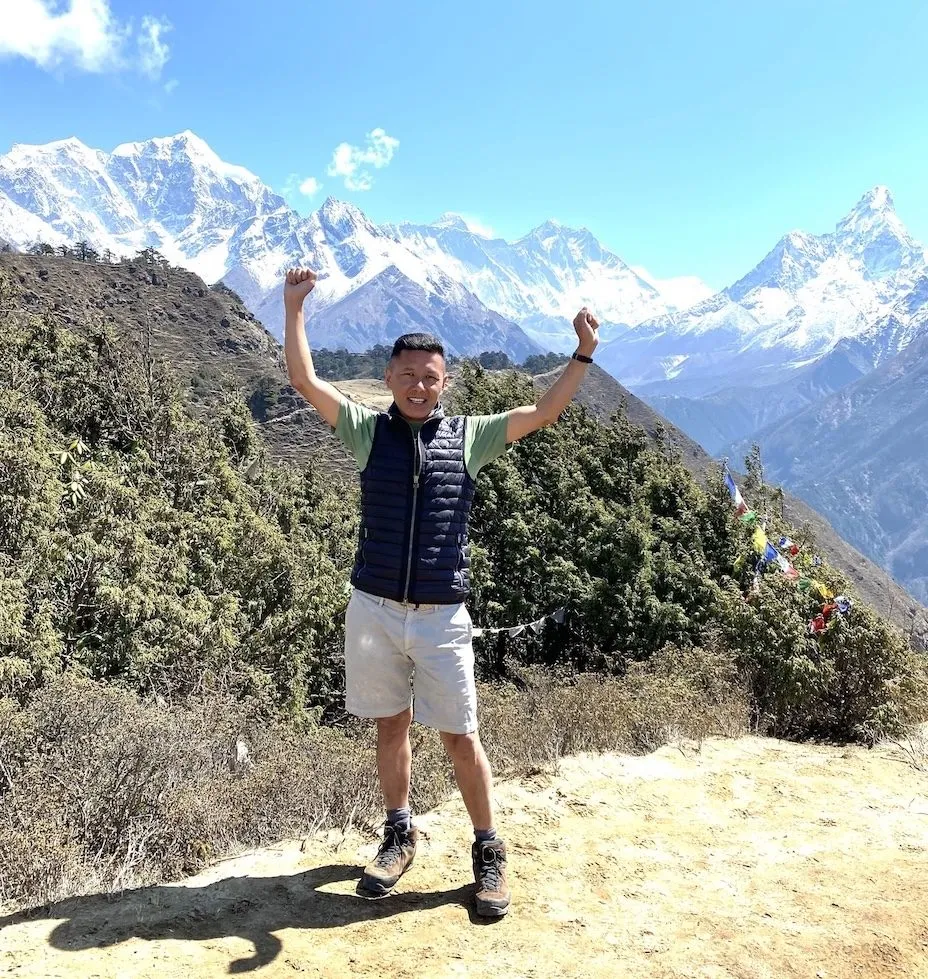
I was born in the mountains, and raised among some of the highest peaks on Earth. I am a proud native Sherpa. My home village of Sailung, Daduwa lies in the Ramechhap District in the Eastern part of Nepal, not far from the Everest region, the world’s highest mountain.
The specialist, I design your trip to the Himalayas; I have explored and guided the country and its regions many times, and I live here. My first-hand knowledge gives you the belief that no other travel company can match our expertise in helping you plan your trip to the Himalayas of Nepal, Bhutan & Tibet.
Since its start, Magical Summits has been super-powered by you, our community; when you “travel” it, we create it. We’re on a mission to make travel better with clean, award-winning adventures that are sustainable and conscious of the planet we share.
Thank you for being a part of our journey.
